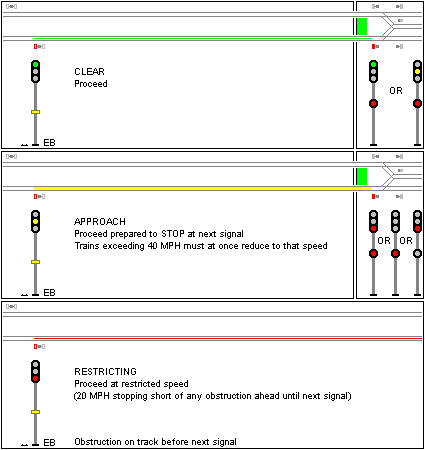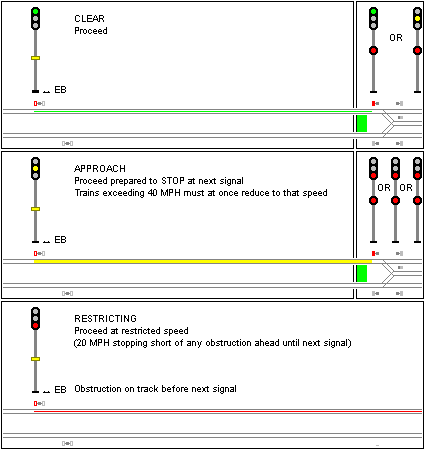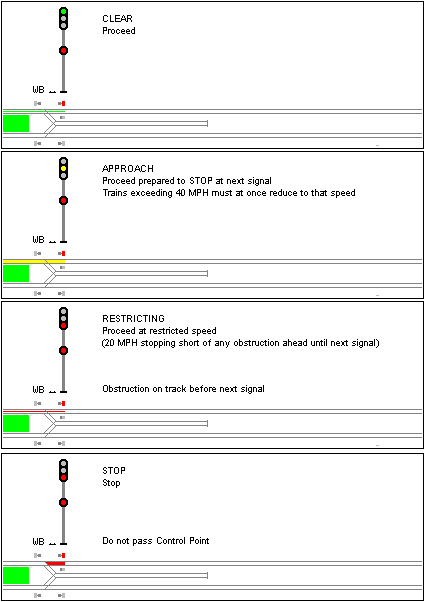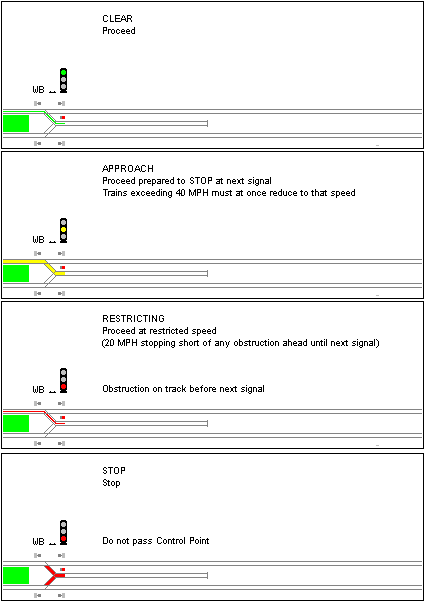NICTD Signal Aspects for 597-1, 597-2 and Control Point 58.8 | |
| The signal aspects possible for 597-1 and 597-2 (intermediates west of Gary Metro Center) and CP 58.8 (Gary Metro Center) are provided here as examples of the signal aspects used on the NICTD South Shore line. Permission for a train to pass a Control Point (CP) signal is controlled by the dispatcher. If permission to pass the control point is granted track conditions (configuration, occupancy and next signal indication) affect what signal is displayed. Eastbound Trains - Normal Right Hand Running | |
| Intermediate Signal 597-1 Intermediate signals are not dispatcher controlled and the display is based only on track conditions. |
CP 58.8 Eastbound Track 1 For the first three examples the dispatcher has granted permission for a train to go straight past the control point. The fourth example shows STOP ... the dispatcher is not allowing traffic to pass the CP on this track in this direction. The fifth example shows permission to move a train off of the mainline to the "add" storage track. |
 The "Restricting" indication shown on an intermediate signal could reflect track occupancy (a train on the track segment beteen that signal and the next signal) or an authorized opposing move. (If the dispatcher clears a train westbound on Track 1 at CP 58.8, signal 597-1 will show "Restricting" regardless of the presence of a train.) There is no "STOP" on intermediate signals. The presence of the number plate changes a "Stop" indication to a "Restricting" signal that a train may pass under the rules. Restricting signals allow a train to proceed prepared to stop short of any obstruction. This aspect would be seen at a CP signal if the dispatcher is allowing a train to pass a signal before a train beyond the CP has cleared the track. While "restricting" allows movement, speed is limited to being able to stop in half sight distance - no greater than 20 MPH. Waiting for the track ahead to clear (waiting for the signal to change to "Approach" which allows 40 MPH travel) may allow faster overall train movement. A "Restricting" signal at CP 58.8 eastbound would allow a train to clear the platform for a following train's arrival. A "Stop" signal at a Control Point is absolute and must be cleared by the dispatcher before the train proceeds. |  "Restricting" is the best signal to use for a train that is routed into the "add" track as the train would be permitted to advance as far as needed on that track short of the bumper at the east end or any cars already on the "add" track. |
Eastbound Trains - Left Hand Running The signals are identical for trains eastbound on Track 2. | |
| Intermediate Signal 597-2 | CP 58.8 Eastbound Track 2 |
 Left hand eastbound running has been used when trains are closely spaced and running both trains on track 1 would cause the following train to be recieving approach or restricting indications at every signal. Trains that terminate at Gary then return to Chicago normally arrive on Track 1 with a restricting signal allowing movement to the add track. They then move from the add track to Track 2 to become a westbound train. In some cases a dispatcher will cross a train over at CP 64.9 or CP 61.5 and the train will reverse direction while at the platform on Track 2. |  |
| Westbound Westbound trains at CP 58.8 enter Gary Metro Center station after passing through the control point. For the first three examples in each column the dispatcher has granted permission for a train to go past the control point. As above, the signal shown changes based on track conditions. The fourth example shows STOP ... the dispatcher is not allowing traffic to pass the CP on this track in this direction. The examples shown are for an westbound on Track 2 (normal right hand running). The signals for a westbound on Track 1 are similar. Trains originating from the add track follow the signals shown to the right. | |
| Westbound Track 2 - Normal Westbound Traffic | Westbound Add Track - Trains originating in Gary |
 |  |
| The defined meaning of the signals on all above charts is as shown in the Chicago Operating
Rules Association guide (CORA), 6th Edition, dated October 1, 2007. Additional notes have been added to
increase understanding. Signal configuration at each site is by personal observation. NICTD uses approach lit signals on the CTC controlled section of their mainline. Siding signals such as the "add" track dwarf signal are constantly lit. There are no immediate plans to upgrade the station at Gary Metro Center, however several proposals have been put forth to rebuild the station at the current location or build a new station at a new location. To see one potential proposal and signals involved, click here. | |